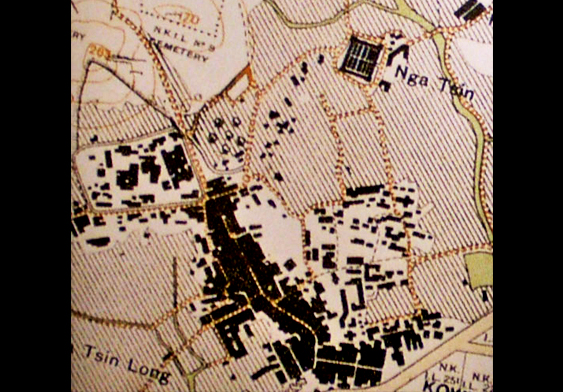
An old map of Tung Tau Village
Tung Tau Village consisted of scattered houses sandwiched between Nga Tsin Wai and Kowloon Walled City-A topographic map made by Public Works Department in 1924 (extracted), in Hal Empson, Mapping Hong Kong : a historical atlas (Hong Kong : Govt. Printer, 1992).
An old map of Tung Tau Village
Tung Tau Village consisted of scattered houses sandwiched between Nga Tsin Wai and Kowloon Walled City-A topographic map made by Public Works Department in 1924 (extracted), in Hal Empson, Mapping Hong Kong : a historical atlas (Hong Kong : Govt. Printer, 1992).
In Tung Tau Village of the pre-war era, houses were dispersed and residents had both indigenous and non-indigenous surnames
CK Ng lived in Tung Tau Village. His doorplate wrote ‘5A Lai Chi Yuen Tung Tau Village’. The big house did not come with a mailbox and the postmen dropped the mails on the floor. Tung Tau Village was vast and Lai Chi Yuen was one part of it. Tung Tau Village in that era was gone, and replaced with the high rising buildings as seen everywhere today. In Tung Tau Village most houses were single-storey stone houses of about 200 or 300 square feet each. Some had little mezzanines. As they were quite scattered, it was hard to tell the total number of houses in the whole village. To CK Ng, Tung Tau Village should not be regarded as a village, but only Nga Tsin Wai, where the houses were arranged more orderly, could be said as a village. What’s more, Tung Tau Village residents had mixed surnames such as Ng, Lee and Tong, but there was no dominant surname. Some people in there grew vegetables and raised pigs. While watercress was most commonly grown, sweet potato shoots were grown as a pig food by quite a number of people, who had built independent pigsite beside their houses. CK Ng’s family had also once raised pigs. The houses in Lai Chi Yuen were also quite scattered, and most of them were built on the field.


 BACK
BACK  CLOSE
CLOSE 